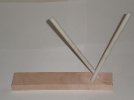Even some 'steels' made of steel are 'sharpeners'. If it removes metal from a knife edge, as evidenced by the black dust seen if wiping the rod with a clean, white rag or paper towel, it's abrading the steel of the knife's edge. A grooved steel, especially, will remove a significant amount of metal from the edges of most knives. Sharpening steels are pretty hard as compared to most knives, and sometimes have relatively high carbide content (carbides are much harder), so they're very capable of removing steel from a knife edge. A smooth glass or high-polished smooth 'steel' will remove the least amount of metal from an edge, and these are the ones that primarily function to realign edges, as opposed to honing/sharpening them.
Having said all that, there's a point at which the metal removal will become insignificant, as compared to regular stones or even fine ceramics. The alumina in ceramic rods is extremely hard, and will therefore always remove some steel from a knife edge (again, as seen in the dark streaks of metal dust left on the ceramic). This isn't to say ceramics can't also be used to realign edges; it's just that they'll also 'hone' the edge as they do so. Done properly, that's usually a good and desirable thing anyway.
The hardness of the ceramic is what will provide some advantage in honing or touching up very high-wear steels with high carbide content (S30V, D2, ZDP-189, etc.). Regular 'steels' for typical kitchen knives wouldn't be as effective in that role, if some actual 'sharpening' is needed or desired in touching up a knife edge.
Something else to think about, very hard or high-wear steels would be less likely to roll at the edge like a typical kitchen knife in soft(ish) low-carbon stainless steel. Harder and high-wear steels would therefore benefit more from touch-ups on a ceramic, as opposed to just being 'realigned' on a regular steel, as can work well on softer/more ductile kitchen knives.
David

